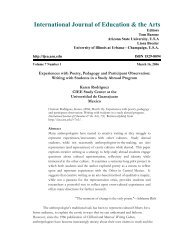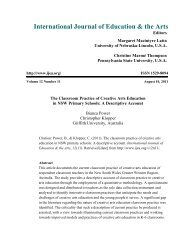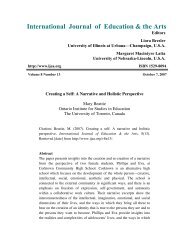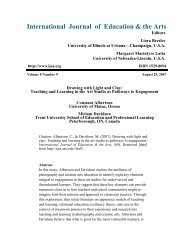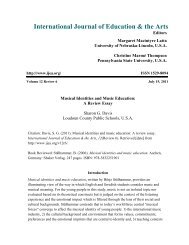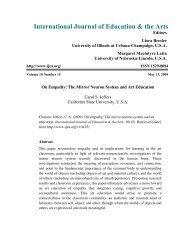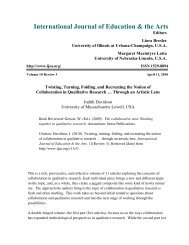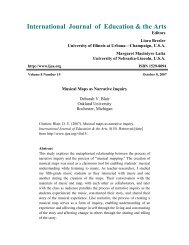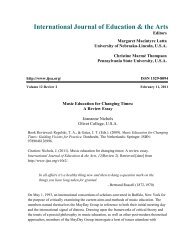The Rewards of Art Criticism in Art Education: A Review Essay ...
The Rewards of Art Criticism in Art Education: A Review Essay ...
The Rewards of Art Criticism in Art Education: A Review Essay ...
Create successful ePaper yourself
Turn your PDF publications into a flip-book with our unique Google optimized e-Paper software.
http://ijea.asu.edu/v7r2/ 6<br />
<strong>in</strong> their efforts with <strong>in</strong>tr<strong>in</strong>sic enjoyment <strong>of</strong> the pursuit, ga<strong>in</strong> new <strong>in</strong>sights <strong>in</strong>to the world<br />
and their experiences <strong>of</strong> it, and are even <strong>in</strong>spired to change how they live” (p. 36).<br />
F<strong>in</strong>ally, for Barrett it is critical to articulate one’s response to the artwork. He<br />
facilitates this with the elementary and high school students when he asks them to<br />
write their <strong>in</strong>terpretations <strong>of</strong> Magritte’s pa<strong>in</strong>t<strong>in</strong>gs. He expla<strong>in</strong>s, “When writ<strong>in</strong>g or tell<strong>in</strong>g<br />
about what we see and what we experience <strong>in</strong> the presence <strong>of</strong> an artwork, we build<br />
mean<strong>in</strong>g; we do not merely report it” (p. 202). <strong>Art</strong>iculation <strong>of</strong> visual and verbal <strong>in</strong>quiry<br />
is part <strong>of</strong> the <strong>in</strong>terpretive process. Barrett does not discuss how an artistic response<br />
might also be an articulation <strong>of</strong> an <strong>in</strong>terpretation (although he does reference artistic<br />
responses <strong>in</strong> the last chapter).<br />
Barrett’s approach may be summed up by the words that are central to the title<br />
<strong>of</strong> the book—reflect<strong>in</strong>g, wonder<strong>in</strong>g, and respond<strong>in</strong>g. He reflects on what he knows<br />
about the artist, the context <strong>in</strong> which he worked, and what he sees <strong>in</strong> the pa<strong>in</strong>t<strong>in</strong>g,<br />
literally and metaphorically. He wonders what he can learn through research guided by<br />
<strong>in</strong>quiry questions. Based on prior experiences and new knowledge he constructs an<br />
<strong>in</strong>terpretation and articulates it verbally—this is his response to the pa<strong>in</strong>t<strong>in</strong>g.<br />
Barrett concludes the first chapter by describ<strong>in</strong>g what he considers to be a<br />
good <strong>in</strong>terpretation <strong>of</strong> a work <strong>of</strong> art. It is worth reproduc<strong>in</strong>g here as it lays out, <strong>in</strong><br />
general, the pr<strong>in</strong>ciples he will explicate <strong>in</strong> the rest <strong>of</strong> the book.<br />
In general, good <strong>in</strong>terpretations are those that satisfactorily provide<br />
answers to questions <strong>of</strong> mean<strong>in</strong>g posed by viewers <strong>in</strong> response to works.<br />
A good <strong>in</strong>terpretation is one that satisfies your curiosity about the<br />
artwork that is <strong>of</strong> <strong>in</strong>terest to you. It is one that clearly relates to what<br />
you can see <strong>in</strong> the work, one that expands your experience <strong>of</strong> the work,<br />
one that leads you to th<strong>in</strong>k further about artworks and ideas, and one<br />
that motivates you to explore more artworks and ideas on your own. A<br />
good <strong>in</strong>terpretation is one that gives you knowledge about the work and<br />
about the world and about yourself as an explorer <strong>of</strong> works and worlds,<br />
one that is satisfy<strong>in</strong>g to others who are <strong>in</strong>terested <strong>in</strong> the work, and one<br />
that allows you to make mean<strong>in</strong>gful connections between Magritte’s<br />
work, for example, and the th<strong>in</strong>k<strong>in</strong>g <strong>of</strong> others as expressed <strong>in</strong> [other<br />
discipl<strong>in</strong>es]…<br />
<strong>The</strong> position <strong>of</strong> this book is that there is no s<strong>in</strong>gle right <strong>in</strong>terpretation<br />
for <strong>The</strong> Postcard, for example, nor will there be one forthcom<strong>in</strong>g, but that<br />
some <strong>in</strong>terpretations <strong>of</strong> <strong>The</strong> Postcard are nevertheless better than others:<br />
that is, more <strong>in</strong>sightful, better conceived, more responsive to what is <strong>in</strong><br />
the pa<strong>in</strong>t<strong>in</strong>g and <strong>in</strong> harmony with the societal and <strong>in</strong>tellectual milieu <strong>in</strong><br />
which the pa<strong>in</strong>t<strong>in</strong>g was produced. (p. 37)




